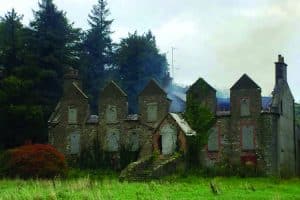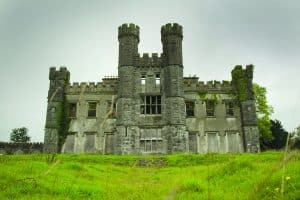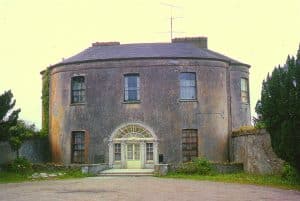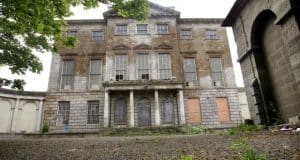Heritage and the Irish Psyche
The cynic who knows the price of everything and the value of nothing drives the perception of properties in Ireland. There is a belief within the Irish psyche that new is best, even when it comes to our historic properties. We flock to perambulate around our country houses and their gardens once they have been restored, often to the point of sanitisation. However, we wince at the sight of a crumbling beauty, and the mere thought of the cost and effort it takes to bring it back to glory. There are thousands of derelict historic properties strewn across the country. Our planning laws are toothless and we seem unable to incentivise maintenance, most particularly of accommodation over shops. Shifts in our economic and political landscape also frame how we perceive this cultural legacy, often alien in design but built, beautifully, by Irish artesans. It is only a generation ago that one of the major factors leading to the demise of the country house was de-roofing as owners struggled to find ways to avoid paying oppressive rates. The National Attitude towards these buildings has evolved from hostility to indifference without anyone noticing. Hostility only resurfaces when there’s any sort of economic (or social) imperative.
The Regime for Protection
Who protects it?
So whose job is it to look after significant buildings? Legislation enables Local Authorities to protect buildings and to take action if they are vulnerable. However, lack of funding, resources, manpower and wit; the cost of litigation; and inertia militate against, and there is – at bottom – no legal obligation for local authorities to do anything, so mostly they don’t. One way to protect a historic property is to list it on the Record of Protected Structures, and especially if built before 1700, the Record of National Monuments. Each Local Authority puts together a Protected Structures list for each Development Plan taking suggestions from the National Inventory of Architectural Heritage, a unit of the Department of Culture, Heritage and the Gaeltacht. As valuable as this database is, it is only a representative sample of the architectural heritage of each county and not updated regularly. For example Limerick Cty’s was last conducted in 2005.
Volunteers
For such a small country numerous charities have been set up to raise awareness of and restore our historic properties. An Taisce, established in 1948 owns many properties including Booterstown Marsh, the Boyne Canal and Crocnafarragh blanket bog, Glenveagh, in Donegal. The Irish Georgian Society has restored many properties and provides strategic funding for particular conservation projects such as some on Henrietta Street in Dublin. The Buildings of Ireland Charitable Trust set up in 2005, the Irish Heritage Trust was established in 2006 as a joint initiative between the voluntary sector and the government, receiving approximately one third of its financial support from the State. So far its projects have been Fota House and Gardens, Strokestown Park, and the Irish National Famine Museum in Roscommon – with Johnstown Castle, Estate and Gardens (Wexford) proposed for the coming years. The Irish Landmark Trust for Ireland, a non-profit organisation set up in 1992 has restored 30 properties. Public and private owners typically agree to let it take properties on 50-year leases that allow them to make them suitable for holiday accommodation. Once a lease expires, the property reverts to the owner. Dublin Civic Trust provides pro-active advice on Dublin and completed an audit ‘Dublin’s Wasting Assets’ in 1997 which was revisited in 2001 and 2010.
Irish Buildings at Risk
Buildings at Risk are heritage assets, such as protected structures or scheduled monuments that are at risk as a result of neglect, decay or inappropriate development, or are vulnerable to becoming so. A major part of this is a lack of property maintenance. We don’t give servicing our cars a second thought but yet we question the upkeep of these hard-working living machines.

As to buildings that become dilapidated a national buildings at risk register would raise awareness of problems and act as a catalyst in marrying up potential resources with suitable available properties. Robert O’Byrne, Vice-President of the Irish Georgian Society, who writes on vanishing period homes in The Irish Aesthete blog, advocates such a register. “By having a list you raise its profile: you raise the security level. Otherwise buildings at risk can be invisible. A long-term ideal would be an annual buildings list like the World Monuments Fund Top Ten”. Not everyone shares this enthusiasm: one retired senior advisor to the Department told me that a register would be “a shopping list for thieves”. He believes it would leave the Department open to legal action from property owners citing the public list for the robbery of their original fireplaces or the lead from their roofs.
Geraldine Walsh, CEO of Dublin Civic Trust notes: “Yes, An Taisce have compiled an excellent Buildings at Risk document, but an annual review of it should be funded by the State in order to independently maintain the process and to keep the list of the buildings identified updated. It should be co-ordinated with the local authorities’ Derelict Sites database. The UK NGOs, including English Heritage, Historic Environment Scotland, Ulster Heritage Society and SPAB all publish their list of buildings at risk annually. A particularly useful aspect of their work is publicising those properties that are available for sale to prospective purchasers”.
Lists of vulnerable buildings are not enough, as Will Derham, author of ‘Lost Ireland, 1860- 1960’ points out: “As we have seen recently in the renting sector, building standards require enforcement. A statutory buildings-at-risk register would be a small, but welcome step in the direction of fully protecting and preserving the nation’s built heritage”. But a State that lacks a culture of enforcement, from banking to spatial planning to police accountability, needs to think hard about how it is going to handle the more ethereal imperative of historic-building conservation and restoration.

International Experience of Buildings at Risk
In England an annual Heritage at Risk Register is published by Historic England, a government agency. The survey is used by national and local government, a wide range of individuals and heritage groups to establish the extent of risk and to help assess priorities for action and funding. Duncan Wilson, CEO of Historic England commenting on the most recent one published on 26 October said: “The Heritage at Risk Register is an annual health-check of the country’s most special and vulnerable historic places. We can celebrate the fact that 387 historic sites have been saved this year across England. The historic environment has a profound impact on our culture and identity as well as on our economy, both locally and nationally, and it’s irreplaceable”. In saying that, apart from in London, only listed buildings with the upper grades of I and II* are included on this list”. It’s a model for Ireland.


An Taisce’s Register
The National Trust in the UK, with a membership of over 5 million people, maintains 200 properties which it opens to the public for a small entry fee. In Ireland the national trust is An Taisce. An Taisce runs a register of what it considers to be the most significant buildings vacant and falling into a state of disrepair. Ian Lumley, its Heritage Officer, explains: “It is maintained by volunteers with no government funding. The process is to identify the buildings of greatest architectural importance at risk within a particular country or area to generate public awareness and form the basis for priority action and response. An Taisce without any financial support has maintained a national risk database in Ireland focusing on the most important building in each country, with detailed inventories for Dublin and Limerick Cities”.
Modernist Vulnerability
It is not just our period properties that are vulnerable. Shane O’Toole founded DoCoMoMo Ireland, which is devoted to the architecture of the modern movement, in 1991. The threat today to our 20th-century heritage is greater than ever before. The same cynical arguments that were used in the 1960s and 1970s to condemn Georgian Dublin fill the air at planning hearings particularly in Dublin. The buildings targeted for redevelopment are ‘past their sell-by date in terms of functional viability’, ‘irredeemably unlovable’, Money is at the heart of this, as always. Today’s most threatened sites are once again in Dublin 2 and Dublin 4, the most valuable real estate on the State’s Monopoly Board and the part of the city least in need of new investment. Of course Dublin City Council benefits directly from the levies that result from these permissions, and there is a voguish if blind national policy obsession with densification, so it is hardly surprising that it resists the addition of almost any mid-century buildings to the Record of Protected Structures.


Particular Cases
Losses
With properties unsecured they are left open to vandals which often results in deliberate fires as with Vernon Mount, Douglas on the south side of Cork City in July last year. Cork mourns the incalculable loss of this fine late eighteenth-century house with its delicate curves in its round-headed stairwell window and end bows. As with the absentee landlords of the nineteenth century, this property is owned by US-based developer Jonathan Moss who bought the building and its 19 acres of parkland in 1997. There are calls by local councillors for it to be taken into public ownership.
The greatest loss of 2017 has to be Carstown House in Termonfeckin, County Louth, a magnificent structure of national significance, which burnt down last month. This distinctive detached fivebay, single-storey-over-basement house with elegantly-pointed dormer windows and gable-fronted porch was built in 1612. Although vacant for many years its seventeenth-century interiors were still intact. Again this property suffered from a private owner not willing to put any work into it. Louth County Council will not seek to take control because it simply would not have the funding needed to restore or maintain the building.
Dubious Developments
The longer a structure is left vacant the more likely it is to be vandalised or cross beyond the point of possible repair. However, insensitive development can be just as damaging. Earlier this year, Dublin City Council granted planning permission to Reliance Investments Ltd to construct 9,290 sq m of office space in two five-storey blocks on either side of Aldborough House on Portland Row. It is the last major Dublin Georgian Townhouse, second in size only to Leinster House built in 1795 for the 2nd Earl of Aldborough. In a submission to the Council, the Department of Arts and Heritage stated: “The height and location of the new office buildings surrounding Aldborough House would dominate the historic building and could compromise its architectural integrity”. Kevin Duff of the Dublin City Association of An Taisce told the Council the current plan “would engulf and emasculate Aldborough House”. The repair of the house and the security of its future are urgently needed, but the proposal seems to call for significant revision.


An Irish Solution
As our current system stands each Local Authority compiles its own list of protected structures and internal lists of properties in a perilous condition for viewing on request and they in turn apply to the Department for conservation grants. A public National Register of Buildings at Risk would dramatically increase the awareness of the current state of these buildings and put pressure on owners. Analogous to the idea of a planning regulator, consideration should be given to a heritage regulator, with power to intervene to ensure buildings at risk are treated properly. Unlike the planning regulator it must have the power to regulate and not merely advise local authorities. In the teeth of the sums of money that can be made by speculative demolitions it is important above all that a new regime be comprehensive, stringent, mandatory and effective.
Emma Gilleece